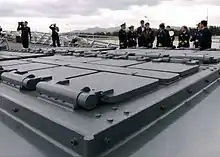HQ-16
The HQ-16 (simplified Chinese: 红旗-16; traditional Chinese: 紅旗-16; pinyin: Hóng Qí-16; lit. 'Red Banner-16'; NATO reporting name: CH-SA-16)[3][4] is a medium-range surface-to-air missile (SAM) from the People's Republic of China. It is derived from earlier versions of the Russian Buk missile system.[1][2]
| HQ-16 | |
|---|---|
 HQ-16A ground launcher | |
| Type | Surface-to-air missile |
| Place of origin | People's Republic of China |
| Service history | |
| In service | 2011 – present |
| Used by | Primary user: China See Operators section for others |
| Production history | |
| Manufacturer | Shanghai Academy of Spaceflight Technology (SAST) |
| Specifications | |
Detonation mechanism | impact / proximity |
| Engine | rocket motor |
| Propellant | solid fuel |
Operational range |
|
Guidance system | |
Launch platform | |
Development
Development began in 2005, and was reportedly assisted by the Almaz-Antey Corporation.[3] It was initially developed as a naval system.[1] In late-2011, China reported the "co-development between Russia and China" of the missile was complete.[3]
The HQ-16B was developed by late-2011.[3]
A ground battery consists of a command post, two multifunction radars, and four to six launchers. Each launcher has six missiles.[1]
Operational history
The platform for the HHQ-16, the Type 054A frigate, entered service in 2008.[5] The HQ-16A entered service in 2011.[6]
The HQ-16A entered Chinese service in 2011.[6]
Pakistan entered negotiations to purchase the missile in 2015.[7] The LY-80s entered service with the Pakistan Army in March 2017.[8]
Variants

- HQ-16A
Original land-based variant[1] with a range of 40 kilometres (25 mi).[6]
- HHQ-16
Naval variant.[2]
- HQ-16B
Improved variant with slant range exceeding 70 kilometres (43 mi).[1]
- HQ-16C
Improved variant with slant range exceeding 70 kilometres (43 mi).[1]
- LY-80
Export variant.[9]
- LY-80N
Export naval variant.[9]
- HQ-16FE
Improved variant with range up to 160 kilometres (99 mi).[10]
Operators
- People's Liberation Army Ground Force - 200 HQ-16A & HQ-16B[11]
- People's Liberation Army Navy - HHQ-16.[12]
LY-80, LY-80N.[9]
References
- United States Department of the Army 2021, p. C-3.
- Schwartz 2015, p. 28.
- Fisher, Richard D. Jr.; Gibson, Neil (7 September 2016). "China develops longer-range HQ-16 SAM variant". janes.com. Archived from the original on 10 October 2016. Retrieved 10 October 2016.
- "6 Asia". The Military Balance 2023. 15 February 2023.
{{cite book}}:|work=ignored (help) - Dominguez, Gabriel (15 January 2018). "PLAN inducts Type 054A frigate into North Sea Fleet". IHS Jane's 360. Archived from the original on 16 January 2018. Retrieved 21 January 2018.
- Cazalet, Mark; Dominguez, Gabriel (1 March 2021). "Air-defence brigade under PLAGF's 78th Group Army receives HQ-16 SAM systems". Janes. Retrieved 17 November 2022.
- Einhorn & Sidhu 2017, p. 54.
- "Army inducts Chinese-built air defence system to its arsenal". Dawn.com. 12 March 2017. Retrieved 17 November 2022.
- The International Institute for Strategic Studies 2022, p. 298.
- Chan, Minnie (15 November 2022). "China showcases latest missile defence systems at Zhuhai air show". South China Morning Post. Retrieved 3 February 2023.
- The International Institute for Strategic Studies 2022, p. 257.
- The International Institute for Strategic Studies 2022, p. 258.
Sources
- Einhorn, Robert; Sidhu, W.P.S. (March 2017). The Strategic Chain: Linking Pakistan, India, China, and the United States (PDF) (Report). Arms Control and Non-Proliferation Series. Brookings Institution.
- The International Institute for Strategic Studies (2022). The Military Balance 2022. Routledge. ISBN 978-1-032-27900-8.
- Schwartz, Paul (August 2015). Russia's Contribution to China's Surface Warfare Capabilities: Feeding the Dragon (PDF). Rowman & Littlefield. ISBN 978-1-4422-5879-2.
- United States Department of the Army (9 August 2021). Chinese Tactics (PDF). Army Techniques Publication. Washington, D.C. 7-100.3.
{{cite book}}: CS1 maint: location missing publisher (link)